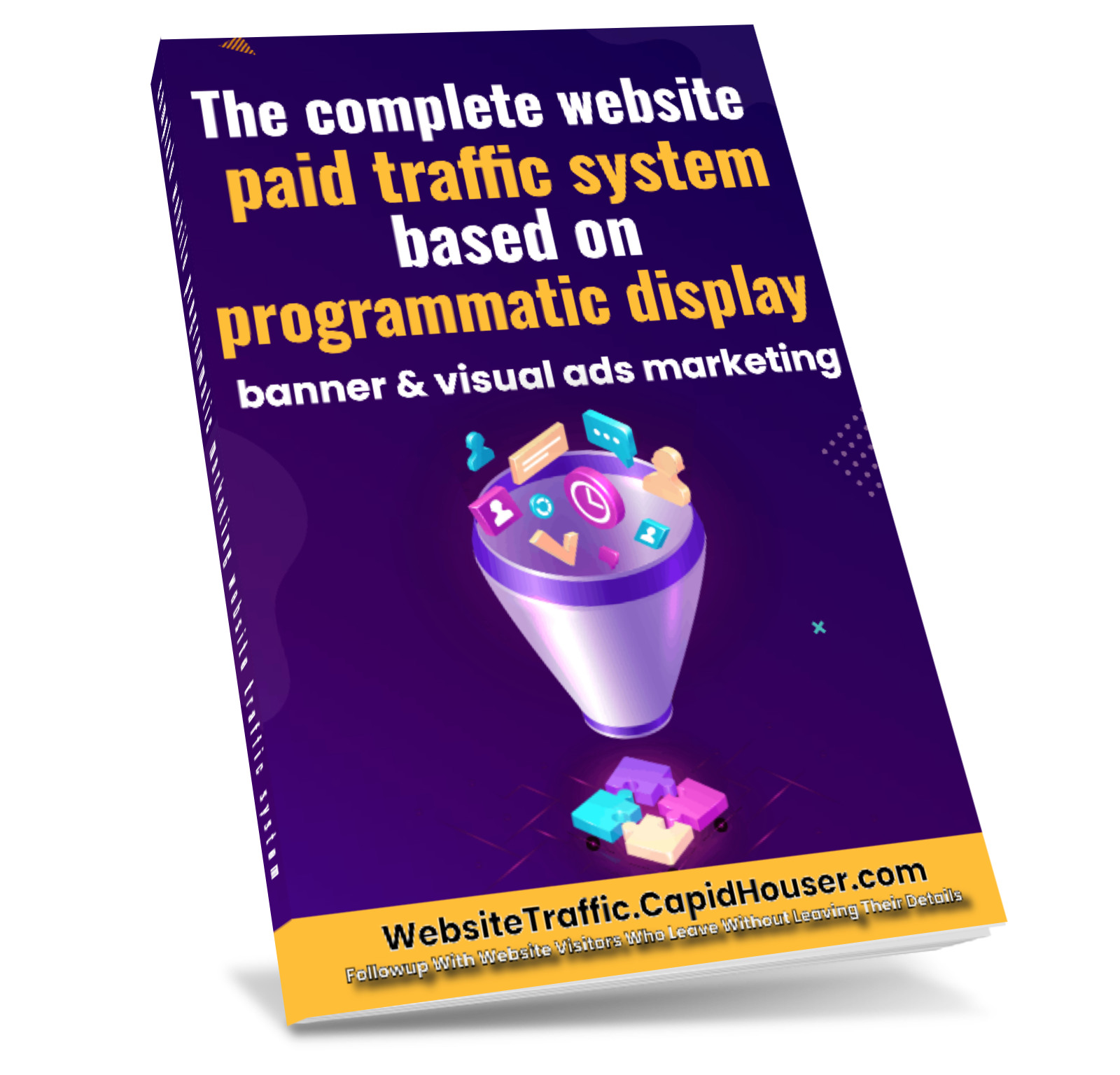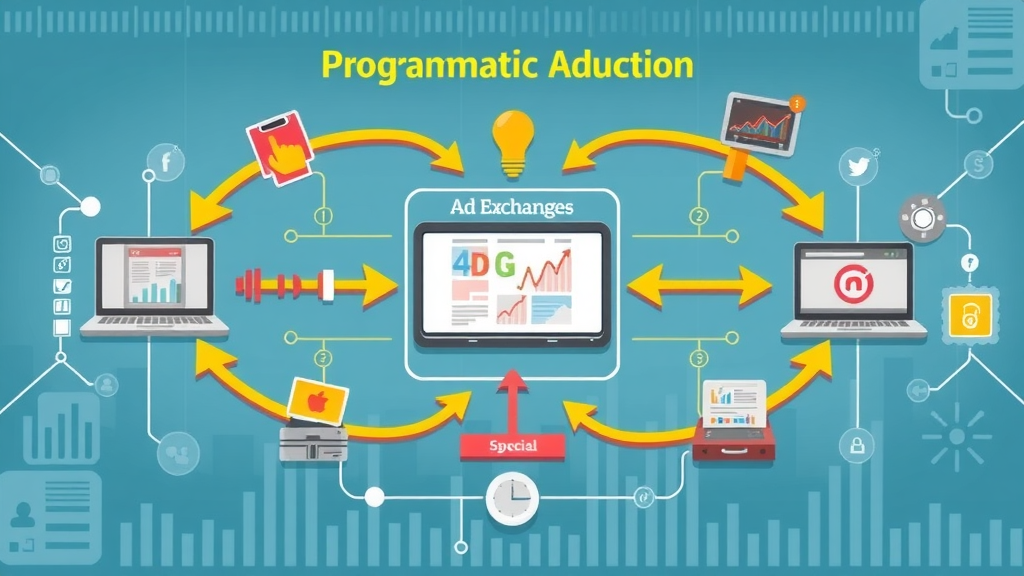Is your advertising truly reaching the right audience at the right time, or are you missing out on game-changing efficiency? In today's fiercely competitive world of digital marketing, one transformative approach is empowering marketers to stretch every pound of their ad spend for maximum impact: display ads programmatic marketing . Whether you're aiming to enhance your reach, boost conversions, or tighten your ad targeting, this educational guide unveils the strategies, technologies, and insider tips to revolutionise your campaigns—no matter your previous experience. Let’s break through the noise and master a future-proof approach to digital advertising.
Can Display Ads Programmatic Marketing Revolutionise Your Digital Campaigns?
Display ads programmatic marketing is rapidly changing the way marketers approach online advertising, but what does it truly offer your business? Instead of manually negotiating and buying ad space, programmatic ad platforms automate the process, allowing you to buy ad inventory and serve digital ads across multiple channels and devices in real time. Media buying has become less about guesswork, and more about leveraging data-driven targeting and optimisation for the best possible returns.
By adopting display ads programmatic marketing, brands can tap into the vast reach of display networks and ad exchanges , ensuring their ads appear in the right placements, to the right users, and at the most opportune moment. This guide will help you navigate the essential differences between traditional display advertising, direct media buying, and the programmatic method, highlighting powerful strategies to drive conversions, avoid common pitfalls, and make every pound of your ad spend count in today’s digital landscape.
How to leverage display ads programmatic marketing for optimal results
The differences between display ads and programmatic ad buying
Insights into programmatic advertising and its components
Strategies to boost conversions with display advertising
Best practices for using display networks and side platforms
Common pitfalls to avoid in media buying and ad exchanges

Understanding Display Ads Programmatic Marketing: Core Concepts and Benefits
What Is Display Ads Programmatic Marketing?
At its heart, display ads programmatic marketing refers to the automated buying and selling of online ad space using sophisticated software, artificial intelligence, and algorithms. Instead of purchasing display ad inventory manually, marketers use programmatic ad platforms, such as demand-side platforms (DSPs), which connect to ad exchanges and media networks to serve ads to highly relevant audiences at lightning speed.
Programmatic advertising encompasses everything from banner ads and video ads to rich media and native display advertising. It’s powered by real-time bidding (RTB), allowing advertisers to compete for ad placements as users load websites. This means your digital ad can reach a specific target audience based on demographics, behaviour, interests, or even intent—maximising relevance and minimising wasted ad spend. As a result, programmatic marketing brings scalability , efficiency , and customisation to any display campaign.
Key Benefits of Programmatic Advertising for Your Business
The primary appeal of display ads programmatic marketing is its ability to automatically optimise the performance and cost of your online advertising. Here are some standout benefits:
Efficiency: Programmatic platforms handle large-scale media buying in milliseconds, ensuring your ads reach audiences faster and with greater accuracy than manual methods.
Precision Targeting: From location to browsing history, programmatic targeting leverages data signals to deliver your message to the ideal user at the ideal time.
Cost Control: Real-time bidding allows you to set specific budgets and bids, helping optimise your ad spend for the best possible ROI on every campaign.
Transparency: Detailed reporting and analytics help marketers track every aspect of their digital campaigns, from ad placement to conversion rates.
Scalability: With access to global display networks and side platforms , programmatic advertising grows with your business needs.

How Programmatic Ads Are Transforming the Display Ad Landscape
Programmatic ads are not just changing how we buy digital ad space—they are reimagining the entire scope of digital marketing. Automated technology enables faster, more responsive bidding, allowing marketers to reach highly segmented target audiences across multiple ad networks and devices with far less manual intervention.
This evolution supports real-time creative adjustments, granular performance tracking, and seamless integration of video, native, or interactive display advertising into complex campaign strategies. As advertisers embrace these changes, they are discovering new ways to capture attention and drive meaningful engagement, all while improving their cost per acquisition (CPA) and overall return on ad spend.
"Programmatic advertising has fundamentally changed the way marketers approach display ad campaigns, making buying and optimisation more data-driven than ever."
How Display Ad Auctions Work: Media Buying, Ad Exchanges, and Platforms Explained

Display Network: Connecting Publishers and Advertisers
A display network serves as the bridge between advertisers wanting to reach audiences and publishers hoping to monetise their content. Major networks like the Google Display Network or other ad networks aggregate huge inventories of available ad space across millions of websites, apps, and even social media environments.
For programme managers and digital marketers, leveraging a display network ensures broad reach and streamlined access to quality ad inventory. Programmatic ad platforms can tap into these networks directly, dynamically adjusting ad placements to respond to evolving user behaviour and interests. In a split second, your banner ad or video ad can be served on a high-traffic blog, a popular app, or a targeted news site—all optimised for your campaign metrics .
The Role of Ad Exchanges and Side Platforms
Central to programmatic ad buying are ad exchanges —marketplaces where ad inventory from publishers is auctioned off to the highest bidder, typically via real-time bidding (RTB). Ad exchanges automate what was once a painstakingly manual process, allowing for real-time, data-driven media buying .
Side platforms —including demand-side platforms (DSPs) and supply-side platforms (SSPs)—further optimise the connection between buyers and sellers. DSPs enable advertisers to automatically bid on and purchase impressions, while SSPs empower publishers to manage and sell their available inventory for the best price. Together, they ensure a balance of transparency, efficiency, and quality in every ad exchange transaction—making programmatic marketing accessible to businesses of all sizes.
Comparison of Display Ads vs Programmatic Advertising vs Direct Media Buying | |||||
Method |
Cost |
Efficiency |
Reach |
Customisation |
Transparency |
|---|---|---|---|---|---|
Traditional Display Ads |
Often fixed or negotiated, less flexible |
Manual process—time intensive |
Can be specific to select publishers |
Limited, dependent on contracts |
Moderate, reporting can lag |
Programmatic Advertising |
Dynamic, based on real-time bidding |
Highly automated, quick |
Global, multi-platform |
Granular: audience, format, timing |
High: real-time analytics |
Direct Media Buying |
Fixed rates, often premium |
Relationship driven, slower activation |
Selected inventory only |
High (if negotiated) |
High (but slower insights) |
Building a Successful Display Ads Programmatic Marketing Strategy
Setting Objectives: What Do You Want To Achieve with Display Advertising?
The foundation of every winning display ads programmatic marketing campaign is a clear set of objectives. Are you focused on generating leads, increasing brand awareness, driving website traffic, or boosting sales conversions? Setting measurable KPIs will help you align your digital ad creatives, targeting, and budget allocation—ensuring every pound of ad spend contributes directly to your business goals.
For example, if your aim is to capture new leads, you may prioritise display ad placements that reach users in specific demographics or geographic regions. On the other hand, if brand recall is your metric, you might invest in high-impact video ad formats across premium display networks . By identifying your primary goals, you’ll be able to select the right programmatic tactics, creative formats, and side platforms that will give your campaign the highest probability of success.

Choosing the Right Programmatic Ad Platforms and Ad Exchanges
Selecting the most effective programmatic ad platforms and ad exchanges can make or break your campaign’s performance. Consider key factors such as platform reach, types of inventory supported, integration capabilities with your analytics stack, and available targeting options. Major DSPs often provide direct access to top ad exchanges and side platforms, making it easier to run display advertising campaigns at scale.
Evaluate each platform’s features: Do they offer support for native, video, and interactive formats? Can they integrate seamlessly with your CRM or data management platform ? Do they provide real-time reporting, fraud protection, and robust audience segmentation tools? Thoroughly vetting each ad network ensures you only invest in technology that truly advances your programmatic campaign objectives.
Optimising Digital Ad Creatives for Programmatic Success
Even the smartest algorithms can’t salvage poor creative. Effective display ads programmatic marketing campaigns rely on engaging, well-designed banner ads, native ads, and video ad assets tailored to your audience and campaign objectives. Make use of dynamic creative optimisation tools, which allow you to test multiple messages, visuals, and offers in real-time, automatically improving ad performance based on user response and behaviour.
Prioritise clear branding, strong call-to-actions, and visual consistency across all your digital ad formats. Don’t overlook ad size, load speed, or mobile responsiveness—each factor can dramatically impact viewability and click-through rates. Monitor how the creative variants perform on different devices and placements to identify winning combinations as data comes in.
Data-Driven Targeting in Display Ads Programmatic Marketing
Utilising Audience Segmentation and Behavioural Targeting
The true power of programmatic advertising lies in its ability to use first-party, second-party, and third-party data to segment and target your audience with laser-like accuracy. Leverage CRM data, website analytics, and purchase histories to create sophisticated audience profiles—then target users based on their behaviours, interests, or even real-time intent signals.
Behavioural targeting enables you to serve online ads to users who have already interacted with your brand, visited your website, or shown interest in similar products or services elsewhere. This form of digital marketing is especially effective for retargeting and nurturing leads further down the funnel.

Leveraging Real-Time Data for Smart Decision-Making
In the realm of display ads programmatic marketing , your greatest asset is real-time data. From bid adjustments to creative swaps, real-time analytics empower marketers to make swift, data-informed decisions that maximise campaign outcomes. Platforms now offer dashboards with instant feedback on everything from impression volume and click-through rates to conversion attribution and ad viewability .
The ability to adapt at speed allows you to pivot ad spend, test new placements, or focus on high-converting audiences without waiting for weekly or monthly reporting cycles. Regularly review your metrics and be prepared to shift strategy as audience interests evolve—success in programmatic ads comes from agility, not rigidity.
Case Study: Programmatic Advertising Success Stories
Many brands have dramatically increased the efficiency and reach of their display advertising through a combination of audience insights and advanced programmatic ad technology. For example, an ecommerce retailer used segmented display network placements and real-time bidding to boost website conversions by over 30%, reducing wasted ad spend while improving ROI.
Another case involved a B2B software company that harnessed cross-channel programmatic ads to identify and retarget high-value prospects. By analysing audience behaviour on both their website and social platforms, they were able to create dynamic ad creatives that resonated, resulting in an upsurge of qualified leads.
"By combining powerful audience data with programmatic ad tech, brands have achieved up to 30% higher ROI from their digital advertising spend."
Types of Display Ads and Programmatic Deals: What Marketers Need to Know

Banner Ads, Video, Native, and Interactive Formats
Display ads come in various formats, each designed for specific marketing objectives and digital environments. Banner ads —rectangular image-based placements—are the most common and versatile, appearing across websites, apps, and even mobile games. Video ads offer immersive brand storytelling and enjoy high engagement on both desktop and mobile platforms.
Native ads blend seamlessly with editorial content, providing value to users while driving brand message subtly and effectively. Interactive ads, which encourage user participation (such as quizzes or shoppable carousels), further boost engagement and click-through rates. Choosing the right mix of ad formats can ensure your programmatic campaign captures attention and drives action at every step of the user journey.
Exploring the 4 Types of Programmatic Deals: Open Auction, Private Marketplace, Preferred Deal, Programmatic Guaranteed
Understanding the major types of programmatic ad deals is vital for digital marketers seeking maximum reach and impact:
Open Auction: Public ad exchanges where inventory is widely available and priced through real-time bidding.
Private Marketplace (PMP): Invitation-only auctions offering higher-quality or premium ad inventory.
Preferred Deal: Pre-negotiated fixed prices and first-look access to select inventory before it enters the open auction.
Programmatic Guaranteed: Direct reservations for inventory at agreed-upon rates, combining automation with the assurance of traditional media buying.
Each approach has different advantages for cost, transparency, and brand safety , so consider your objectives and audience requirements before deciding on the model.
Choosing the Right Display Ad Format for Your Campaign Goals
The ideal display ad format depends on your campaign objectives, creative assets, and budget. For quick awareness, banner ads on a display network provide broad exposure. For deep engagement, a well-placed video or interactive ad can leave a lasting impression. Test various formats and analyse in-platform metrics to identify what resonates most with your target audience—then scale up what works.
Layer in retargeting, frequency caps, and custom messaging to create a holistic user journey. Your digital advertising strategy should adapt to the context—what works for direct response may not excel in brand lift, and vice versa.
Table of Display Ad Types and Formats | |||
Format |
Description |
Best Use Case |
Key Performance Metrics |
|---|---|---|---|
Banner Ads |
Static or animated image ads |
Brand awareness, site traffic |
Impressions, click-through rate (CTR) |
Video Ads |
Short or long-form video placements |
Storytelling, engagement |
View-through rate, engagement |
Native Ads |
Ads that match content style of website/app |
Subtle promotions, lead generation |
Engagement time, conversion rate |
Interactive Ads |
Engage users with quizzes, games, or shoppable units |
High engagement, action-based goals |
Engagement, completion rate |
Digital Marketing Trends Shaping the Future of Display Ads Programmatic Marketing
The Rise of Artificial Intelligence and Machine Learning in Programmatic Advertising
Artificial intelligence (AI) and machine learning (ML) are setting new standards for programmatic advertising effectiveness. AI algorithms can analyse billions of data points in milliseconds, optimising targeting, bidding, and creative rotation based on historical data and live behaviour.
For display ads programmatic marketing, this means smarter segmentation, predictive analytics, and real-time personalisation—all driving stronger performance and return on ad spend. As this technology evolves, expect even sharper audience insights and more adaptive cross-channel integration.

Privacy, Data Regulation, and the Evolution of Display Network Targeting
With consumer privacy and data regulation taking centre stage, programmatic marketers must adapt to new rules around data collection and targeting. Regulations like GDPR and the end of third-party cookies are re-shaping display network targeting, encouraging a shift towards first-party data and privacy-friendly advertising solutions.
Smart marketers are investing in compliant data strategies, contextual targeting, and stronger user consent management protocols. The future of display ads programmatic marketing lies in transparent, responsible data practices that build consumer trust while delivering actionable performance insights.
Cross-Channel Display Advertising and Media Buying Integration
Integration is a core trend shaping the next era of programmatic display. Today’s marketers combine data from multiple channels—social media, search, video, and native display advertising—for a holistic view of audience journeys. Programmatic platforms sync media buying across these channels, allowing for unified budgeting, consistent messaging, and seamless retargeting.
This integration not only increases campaign efficiency but also enables brands to target users with relevant messages wherever they are in the digital world. Monitoring success across channels ensures ads are never siloed, and insights from each touchpoint refine future campaigns.
"The future of digital marketing will be powered by programmatic ads: automated, intelligent, and hyper-targeted."
Common Pitfalls in Display Ads Programmatic Marketing and How to Avoid Them
Addressing Ad Fraud and Viewability Challenges on Display Networks
Ad fraud—such as bots generating fake impressions or clicks—remains a critical challenge in programmatic advertising. Marketers must deploy anti-fraud solutions, such as verification tags and fraud-blocking algorithms, to protect their ad spend and campaign metrics. Equally, optimising for viewability ensures your ads are actually seen by users, not buried at the bottom of a webpage.
Choose trusted ad exchanges and side platforms that provide robust fraud detection and transparent reporting. Always monitor discrepancies in campaign performance to identify suspicious patterns early and adjust your strategy accordingly.

Optimising Programmatic Ad Spend for Better ROI
The automated nature of programmatic marketing is only as effective as the parameters you set. Failing to define strict audience segments, frequency caps, or bid strategies can result in wasted ad spend and poor campaign performance.
Routinely audit all programmatic campaigns for underperforming placements, excessive frequency, or audience overlap. Refine your bidding strategy, creative, and targeting to make every pound deliver measurable value.
Compliance and Brand Safety in Digital Advertising
As the digital landscape becomes more complex, compliance and brand safety are non-negotiable. Always ensure your programmatic partners adhere to regional regulations and standards. Activate brand safety filters to prevent your ads from appearing alongside inappropriate or harmful content, and opt for exchanges that prioritise high-quality inventory and transparent transactions.
Regular compliance checks and creative audits keep your brand’s reputation intact while reducing the risk of costly legal or ethical missteps.
Clearly define campaign objectives and KPIs at the outset
Choose reputable ad exchanges and programmatic side platforms
Optimise creative formats for engagement and quick load times
Implement robust audience segmentation and retargeting
Monitor real-time performance data daily
Activate brand safety and anti-fraud protections
Stay compliant with data privacy regulations
Continuously test and iterate based on analytics
People Also Ask: Key Insights into Display Ads Programmatic Marketing
Are display ads programmatic?
Yes, display ads can be bought and managed programmatically using automated platforms, streamlining the media buying process and improving targeting accuracy.
What are the 4 types of programmatic deals?
The four types of programmatic deals are Open Auction, Private Marketplace (PMP), Preferred Deal, and Programmatic Guaranteed, each with different levels of transparency and exclusivity.
What is a display ad in marketing?
A display ad in marketing refers to graphical advertisements (such as banners or videos) shown on webpages, designed to attract users and drive traffic or sales.
What is the programmatic method of selling display advertising?
The programmatic method uses automated technology and real-time bidding to buy and sell display ad inventory, optimising targeting and spend allocation.
Expert Tips and FAQs on Display Ads Programmatic Marketing
What’s the biggest advantage of programmatic advertising over direct buys?
The greatest advantage is automation—programmatic advertising uses real-time bidding and advanced targeting to deliver more efficient ad placements, ensuring your budget goes further by reaching only the most relevant audiences.
How do you measure success in display ads programmatic marketing?
Success is typically measured through KPIs like impressions, click-through rates, conversions, conversion rate, and return on ad spend (ROAS), all readily available via programmatic platform dashboards.
Can SMEs benefit from programmatic ad platforms?
Absolutely. Programmatic platforms are scalable and increasingly accessible, allowing SMEs to compete with larger brands for quality inventory and audience targeting without breaking the bank.
Does programmatic advertising guarantee brand safety?
While advanced controls and filters greatly minimise risk, no solution is 100% foolproof. It is essential to actively manage brand safety settings and work with trusted platforms.
Actionable Steps to Get Started on Display Ads Programmatic Marketing Today
Ready to make a move? Define your objectives, select the most suitable programmatic platform, create compelling ad creatives, and implement robust data-driven audience segmentation. Monitor results consistently, optimise regularly, and never stop testing new approaches—success is a journey, not a destination.
Let’s Talk Strategy: Elevate Your Results with Professional Display Ads Programmatic Marketing
Contact us at https://www.capidhouser.com/paid-website-traffic/ to discuss your Retargeting & Remarketing strategy
Start applying the best display ads programmatic marketing tactics to your campaigns today, and put your brand in front of the audiences that matter most—efficiently, intelligently, and with confidence.
To deepen your understanding of display ads programmatic marketing, consider exploring the following authoritative resources:
“Programmatic Display and What You Need to Know About Modern Advertising Strategies” : This article delves into the benefits of programmatic display advertising, highlighting how automation, real-time bidding, and advanced targeting can enhance the efficiency and effectiveness of digital campaigns. ( ipromote.com )
“Programmatic Advertising Guide: Definition, Types, & More” : This comprehensive guide provides insights into programmatic advertising, including definitions, types, and best practices, helping you navigate the complexities of modern digital advertising. ( semrush.com )
These resources offer valuable insights into the mechanics and advantages of programmatic display advertising, equipping you with the knowledge to optimize your digital marketing strategies effectively.
 Add Row
Add Row  Add
Add 




Write A Comment